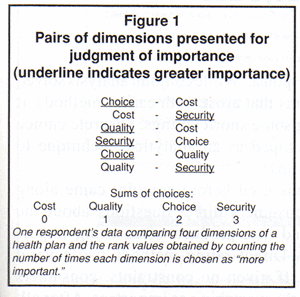Fueled by President Clinton's determination to reform health care, there has been a windfall of research to understand the needs and desires of the public and the many providers and purveyors of health services. Two towering hurdles that researchers must clear in conducting these studies are: translating complicated health coverage-related concepts and jargon into common language; and adopting measurements that can determine the public's priorities among the many important coverage and service components of health plans.
While the health reform debate has raged, Fact Finders Inc., a Delmar, N.Y. research firm, has been conducting research which tracks the public's experiences with health care services and priorities in health care reform. This article will focus on a technique used in the 1994 American Values and Expectations for Health Care Reform Survey, the latest of the annual surveys which the Novalis Corporation has sponsored to measure the needs and preferences of the public regarding any health plan that emerges from health care reform. These public opinion studies, conducted in January of 1992, 1993 and 1994, survey by telephone a representative sample of 1,000 U.S. adults.
In conducting these annual tracking surveys, Fact Finders has gauged public opinion by measuring reaction to underlying precepts of health plans rather than actual initiatives and their components. The challenge of developing an approach to measure receptivity to managed care is an example of the difficulty inherent in measuring public attitudes toward complicated health care initiatives. Measuring receptivity to managed care, a central operational tenet of the Clinton Health Security Act, was extremely difficult in 1993 when 75% of the U.S. population had never heard the term. Almost one-third of those who had not heard the term were actually having their care managed, as evidenced by their report that their health plans required them to call or visit their primary care physician before receiving any routine medical services.
Fact Finders has used the technique of paired comparisons to measure public opinion about health reform designs. Use of this technique has enabled the public to contribute their opinions even when they are not familiar with industry terms and legislative designs. The ensuing is a discussion of the measurement of the public' s preferences for health reform.
Measuring values
Receptivity to health care reform is determined in part by the perceived goodness-of-fit between a person's own priorities in health care and the reform package. In repeated measurements in our surveys and those of others, the public continues to say that the health plan considerations that are important are: quality of services received; availability of services when needed; and freedom to choose the health care provider desired.
Historically, all of these components have been readily available to the pri¬vately insured in the United States through traditional indemnity insurance. However, with the advent of health reform which aims to include the entire United States population in a health plan, prioritizing these significant components has become increasingly important for use in health plan design. In addition, knowing the relative importance of health plan components is useful for developing marketing strategies to expedite the acceptance of health care reform.
Understanding that cost, choice, security, and quality are all important considerations, we examined the relative importance of these dimensions using the paired comparisons measurement technique. This method is more accurate and more valid than rank-order or rating-scale approaches because each dimension is directly compared to each of the other dimensions.
For measurement purposes, we operationalized the key dimensions - cost, choice, security and quality as follows:
- Choice (freedom to choose any doctor)
- Security (always being able to get medical care you need)
- Quality (you see the best-quality doctor)
- Cost (what it costs you for health care)
For the paired comparison technique, each respondent is asked six actual questions, sequentially including each of the six possible pairings, in this format.
Which is more important to you? Freedom to choose any doctor, or what it costs you for health care?
To determine which of the four dimensions ranks "most important," values for each dimension are calculated by counting the number of times each of the dimensions (cost, choice, security, quality) is chosen over any other dimension. (See figures 1 & 2)

By using this technique, we found that by a large margin cost is, at this time, the least important health plan consideration of the public. (See figure 3) Jn further analysis from the 1994 survey, opponents of national health care reform value choice over security, quality and cost. Security is most important to supporters of health care reform.

It is our conclusion that developing valid and reliable measurements of public receptivity to specific health care reform initiatives requires asking questions that focus on personal behavior and values. This allows the general public to contribute their opinions about specific reform proposals or components which are otherwise too complicated by design or too remote due to industry jargon.
